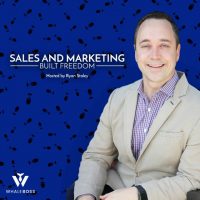Grab your Free Copy of “The 4 Biggest Mistakes That Stop Companies From 10X’ing Their Revenue” at https://www.scalerevenue.io/10x
Anthony Blatner came to the marketing world via the tech side of things.
Anthony is the Chief Advertising Officer at Speedwork Social. He started his career at IBM, doing software development and building e-commerce stores. After leaving IBM, he started a mobile app development agency where he built mobile apps for various companies, from big tech companies down to startups. That was in the very early days of mobile apps, and Anthony saw that some software and apps did well and even went viral with a good marketing or distribution plan.
Anthony found himself getting pulled into helping his clients with their marketing after building apps for them. That was how he made the transition into the world of marketing.
Anthony sold his mobile app development agency several years ago. Since starting Speedwork Social, he has spent several years focusing on LinkedIn ads and B2B. He now helps tech and B2B companies use LinkedIn ads to reach their target customers and manage their ad campaigns.
Links and resources:
Anthony Blatner on LinkedIn
On Speedwork Social website
Anthony’s email – Anthony@speedworksocial.com
LinkedIn ads is a more expensive platform than most other ad platforms, so for your sales funnel calculation, you need your LTV (Life Time Value) to be at least 15K for the ROI (Return on Investment) to make sense on LinkedIn.
Most of the LinkedIn ad campaigns start at between $8 and$12 per click. The lead costs are usually between $50 and $100 to start, depending on who you are targeting.
There are several reasons for using LinkedIn paid ads:
- If you are a B2B company that needs a targeting niche professional at scale.
- Targeting a specific decision-maker at a specific company.
- LinkedIn will be one of the platforms least impacted by the rollout of the iOS 14 changes.
- LinkedIn is the only place to have many of the targeting options for B2B companies.
An example of what a LinkedIn ad campaign would be:
- Start with who you want to target and the offer you would like to put in front of them. (A sales funnel.)
- Package your offer into an ad unit that will show up on LinkedIn and grab someone’s attention, and then position your product or service as a solution or option to help them. (A lead magnet.)
- Once you have an email or someone has been to your website, your sales team can follow up with them directly and move them down the funnel. (The follow-up.)
Anthony recommends a multichannel approach in the follow-up.
When someone signs up for a lead magnet:
- Get them to the next page with the lead magnet embedded on it right away. (That is when they will most want to read it.)
- Send them an email with some links so they can scroll around and learn more.
- Make contact soon after they sign up, and have your sales team ready to call out.
Look for the deal size and the target-ability of your audience.
Your minimum audience size should be around 100 000 people on LinkedIn. Your absolute minimum can go down to about 20 000- 30 000 people if you know what you are doing and who to target.
Anthony does not recommend importing your Facebook campaign to LinkedIn.
The iOS 14 rollout will have an impact on retargeting. Basic retargeting will be limited, and the audiences will be a lot smaller.
An actionable five-step framework for using LinkedIn ads:
- Take your best piece of content (or create something valuable for your industry or target audience)
- Have a good lead magnet
- Create a lead-generation campaign on LinkedIn (Be very specific about who you target)
- Set up a lead-magnet
- Start the rest of your sales process
A tip:
- In your lead form, ask for the individual’s LinkedIn profile URL. That will help you learn more about them to evaluate if you are getting the right people.
- Before you launch, set up a few different split tests so that you can see some performance data coming in over a month.
- If you want to run a small test, ballpark about $3000 for your ads for a month.
- Consider what your typical sales process and sales cycle are.
- Look at how many of your leads have made it through to the next step, and how many people have purchased over three months. (From there, you can start calculating some ROI metrics for your campaign.)
Most people doing extended campaigns spend around $5000 per month.
The biggest mistakes Anthony sees are:
- Targeting too big an audience.
- Trying to drive sales by offering free demos or consultations to people who do not know what you do.
- Trying to start too directly and too fast.
Anthony recommends that you start with image ads. Image ads usually convert a lot better because someone can view an image and digest it immediately.

